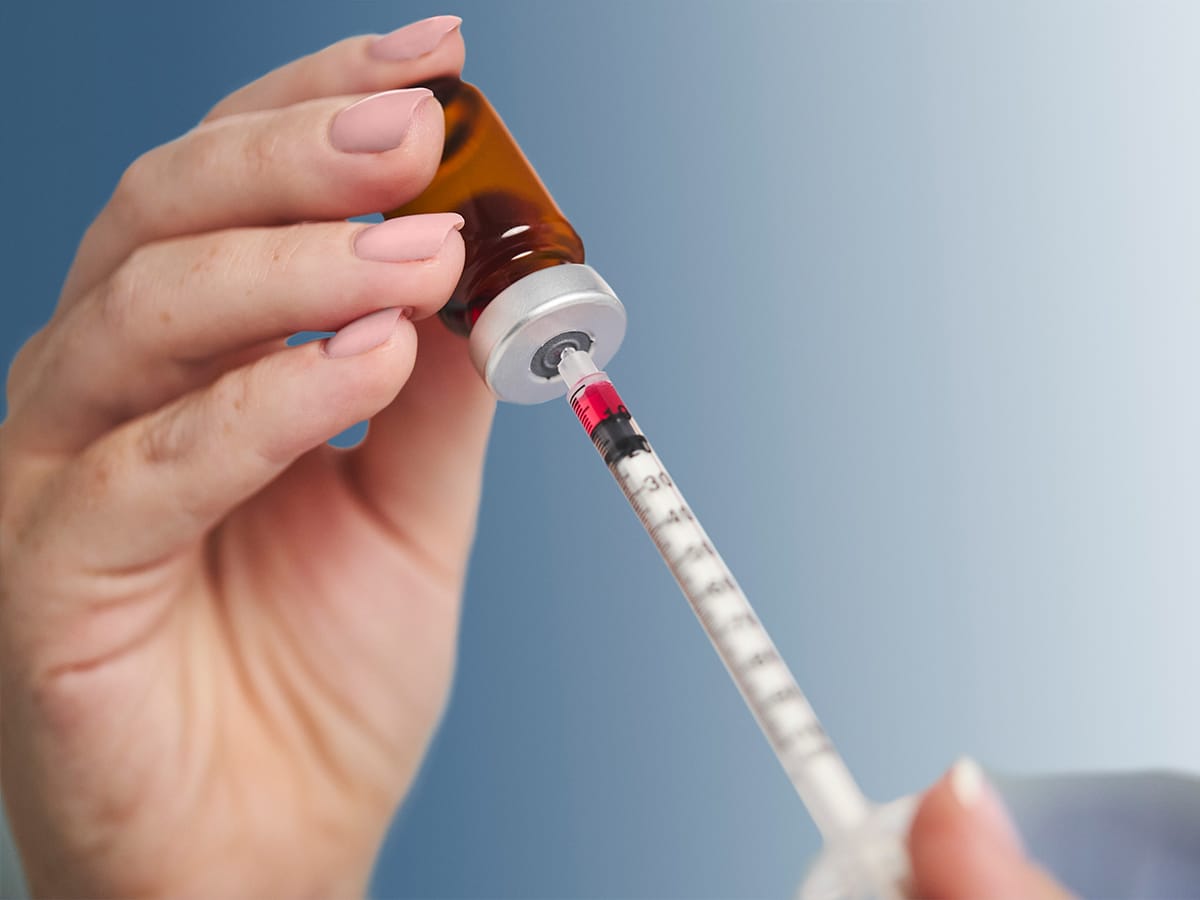How Liraglutide Supports Weight Loss: Mechanism and Effectiveness Explained
What is liraglutide, and is it effective for weight loss? Below, our clinical experts explain how it works, common side effects as well as how to access liraglutide for weight loss.

What is liraglutide, and is it effective for weight loss? Below, our clinical experts explain how it works, common side effects as well as how to access liraglutide for weight loss.
What is Liraglutide?
Liraglutide is the active ingredient in daily injectable medications such as Compounded Liraglutide* as well as brand-name alternatives like Saxenda and Victoza. It is part of a wider class of drugs called glucagon-like peptide-1 receptor agonists or GLP-1s, which also includes other popular brand-name weight loss medications like Ozempic and Wegovy. Liraglutide first gained FDA approval in 2010, under Victoza, for patients with type 2 diabetes, and Saxenda for chronic weight management in 2014. Today, it continues to be prescribed for both the treatment of obesity and for the treatment of type 2 diabetes. [1]
How does Liraglutide Work?
Liraglutide promotes weight loss by mimicking the action of the natural GLP-1 hormone, which is released in the gut after eating. Here’s how it impacts your body:
- Regulates appetite by targeting the appetite control centre brain (hypothalamus) to increase satiety and reduce your appetite.
- Reduces blood sugar levels by stimulating insulin secretion and lowering glucagon secretion when blood sugar is high. This helps prevent the blood sugar spikes that can cause cravings for sugary or high calorie foods.
- Minor delay in stomach emptying which keeps you feeling fuller for longer. [2]
The combination of these factors makes it easier to focus on making healthy lifestyle interventions like reducing portion sizes, eating a balanced diet and exercising.
Clinical Trials and Efficacy
In clinical trials patients who took Saxenda (liraglutide) for 56 weeks lost an average of 8% of their body weight. However, it’s important to note that patients in this trial had an initial body mass index (BMI) greater than 27 before starting treatment. [3]
In 2021, another study found that combining liraglutide with exercise led to greater overall weight loss. This is why liraglutide must be used alongside a reduced-calorie diet and increased physical activity for weight management, including weight loss and weight maintenance. [4]
Safety and Side Effects
Like all prescription medications, liraglutide can cause side effects. These can range from common, easily manageable symptoms to serious side effects that require immediate medical attention.
Mild side effects may occur after starting medication for the first time or immediately after a dose increase.
Common Side Effects
Liraglutide has some very common side effects including: nausea, diarrhea, constipation, vomiting and headaches. [2]
You can manage and prevent these common side effects by making a few simple lifestyle changes while taking your treatment.
- Eat smaller meals more often so that you don’t feel overly full after you eat
- Stay hydrated by drinking enough water. The Mayo Clinic recommends about 15.5 cups (3.7 liters) of fluids a day for men and about 11.5 cups (2.7 liters) of fluids a day for women. [5]
- Avoid greasy or spicy foods that can irritate your stomach
Other less common side effects of liraglutide include: indigestion, fatigue, dizziness, stomach pain, heartburn, bloating, burping, flatulence, injection site reaction and dry mouth.
Serious Side Effects
Rare but serious side effects of liraglutide include pancreatitis, acute gallbladder disease, acute kidney injury and anaphylactic reactions. [2]
Symptoms of pancreatitis (inflammation of the pancreas) may include:
- Severe stomach pain that doesn’t go away, especially if it spreads to your back or right side
- Pain that’s so intense it makes daily activities hard to manage
- Vomiting several times a day, or vomit that looks like coffee granules or has blood
- Pain that doesn’t improve with rest or over-the-counter medication
Signs of a severe allergic reaction (anaphylaxis):
- Difficulty breathing
- Swelling of your lips, tongue, or throat
Signs of gallbladder issues:
- Sharp pain under your right ribcage, possibly spreading to your back or shoulder
- Nausea or vomiting
- Fever or rapid heartbeat
If you experience any of these adverse effects, stop using the medication and seek medical help right away by calling 911 or going to your local emergency department.
Finally, Liraglutide is not recommended for people who have serious liver or kidney conditions or for patients with a family history of medullary thyroid carcinoma (MTC) or with multiple endocrine neoplasia 2 (MEN2). [2] If you develop any of these medical conditions or there are any changes to your medical history, you must notify your health care provider immediately.
Administration and Dosage
Taking your medication correctly and injecting the right dose is essential for safe, effective and lasting results.
How to Take Compounded Liraglutide*
Liraglutide is administered once daily via subcutaneous injection (just under the skin) using a disposable needle.
Prepare for your injection by gathering your supplies, washing your hands, and checking your treatment for signs of damage or expiration.
Then, choose an injection site (abdomen, thigh, or upper arm) and clean the area with an alcohol swab. You should choose a new injection site each time to prevent injection site reactions.
Remove the needle cap and draw up the prescribed dose into the syringe.
Next, insert the needle into your injection site at a 90-degree angle. To inject the medication, slowly push the plunger down and count to 5.
Finally, remove the needle from your skin and cover it with its cap. Dispose of the needle in a hard, plastic container.
Recommended Dosage Guidelines
Most people start on a low dose of liraglutide that slowly increases each week until you reach the maximum dose or the dose that works best for you while giving you the least side effects (also known as a maintenance dose). By slowly increasing, you reduce the odds of side effects and allow your body to adjust to the effects of your treatment.
The starting dose for subcutaneous liraglutide is 0.6 mg for the initial week. This is titrated up every week until a maintenance dose is reached, to allow the body to adjust to the medication.
Your daily doses:
Week 1: 0.6 mg once daily (20 units)
Weeks 2: 1.2 mg once daily (40 units)
Weeks 3: 1.8 mg once daily (60 units)
Week 4: 2.8 mg once daily (80 units)
Week 5 onwards: 3 mg once daily (100 units) (maintenance dose)
If an increased dose during dose escalation, dose escalation can be delayed for another week. However, the FDA recommends that treatment should be discontinued if a patient cannot tolerate the 3 mg dose, as efficacy has not been established at lower doses (0.6, 1.2, 1.8, and 2.4 mg). [2]
Comparison with Other Weight Loss Medications
There are a few key differences between liraglutide and other popular medications like semaglutide (Wegovy) or tirzepatide (Mounjaro). For example, liraglutide is taken daily rather than weekly and may lead to slightly less weight loss on average (8% compared to 15% and 20% for semaglutide and tirzepatide).
What is Compounded Medication?
Compounded medication is a custom made version of a drug prepared by a licensed pharmacist. Compounded medications are used for a whole range of reasons like peronsalizing the dose, removing allergens, or changing the form of a medication. In the case of liraglutide, compounded versions may be used when the brand name option is unavailable or not covered by insurance.
Compounded drugs are permitted to be prescribed under federal law but are not FDA-approved and do not undergo FDA review for safety, effectiveness, or quality.
At ZipHealth, our partner pharmacies are accredited by NAPB and LegitScript, guaranteeing strict adherence to FDA and state regulations. These pharmacies undergo frequent inspections to uphold the utmost standards of quality and safety. Our medications are subjected to rigorous testing, encompassing potency, pH levels, sterility, and endotoxicity checks, ensuring efficacy and safety.
*Compounded drugs are permitted to be prescribed under federal law but are not FDA-approved and do not undergo FDA review for safety, effectiveness, or quality.
References:
[1] https://www.facebook.com/Drugscom. Liraglutide: Uses, Dosage, Side Effects, Warnings [Internet]. Drugs.com. 2024. Available from: https://www.drugs.com/liraglutide.html
[2] HIGHLIGHTS OF PRESCRIBING INFORMATION These highlights do not include all the information needed to use SAXENDA® safely and effectively. See full prescribing information for SAXENDA. SAXENDA (liraglutide) injection, for subcutaneous use Initial U.S. Approval: 2010 ••••••••••••••••••••••••••••••DOSAGE FORMS AND STRENGTHS•••••••••••••••••••••••••••••• [Internet]. Available from: https://www.accessdata.fda.gov/drugsatfda_docs/label/2018/206321s007lbl.pdf
[3] Mehta A, Marso SP, Neeland IJ. Liraglutide for weight management: a critical review of the evidence. Obesity Science & Practice [Internet]. 2016 Dec 19;3(1):3–14. Available from: https://pmc.ncbi.nlm.nih.gov/articles/PMC5358074/
[4] Lundgren JR, Janus C, Jensen SBK, Juhl CR, Olsen LM, Christensen RM, et al. Healthy Weight Loss Maintenance with Exercise, Liraglutide, or Both Combined. New England Journal of Medicine. 2021 May 6;384(18):1719–30.
[5] Mayo Clinic. Water: How Much Should You Drink Every day? [Internet]. Mayo Clinic. 2022. Available from: https://www.mayoclinic.org/healthy-lifestyle/nutrition-and-healthy-eating/in-depth/water/art-20044256
